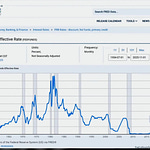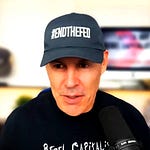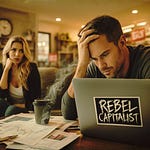If you ever find yourself in a room with Chris Irons from QTR’s Fringe Finance and George Gammon from Rebel Capitalist, one thing’s certain: you’re not leaving without a brain cramp and a chuckle.
It’s like a live wire touching a puddle…energy everywhere, sparks flying, and sooner or later, something’s catching fire.
This past week, the two lit up the mic again.
Topics? Tariffs, debt, and Trump’s boiling feud with Jerome Powell.
The setup? No prep. Just two financial heretics, bouncing un-sanitized thoughts like it’s open mic night at the Fed’s comedy club.
By the end, your portfolio might be trembling…but your understanding of where the world’s headed? Sharpened like a prison shank.
Let’s unpack the madness…
The Tariff Tantrum
It started with the Empire State Manufacturing Index. Expectations cratered to -7.4…the worst since 9/11…but came in at 8.1. Good news?
Not really.
In January, we were sitting at a frothy 36.
February? Down to 22.
March? A sad 12.
Now this.
Chris tried to write it off as a “one-time tariff shock,” like a dog barking in the distance. George didn’t buy it.
The Philly Fed Index was even uglier…tanking to -26.4 against expectations of 3.5.
That’s not a bark. That’s a bite. These aren’t just mood swings; they’re sentiment cliffs.
And sentiment matters.
In markets, how people feel about the future determines what they do in the present.
If business leaders think the economy’s about to crash, they don’t wait…they start slashing budgets and laying people off.
Psychology becomes prophecy.
Fun historical footnote: the Empire State Index didn’t even dip this low during the Global Financial Crisis. We are now beneath Lehman Brothers-level gloom. All for a few tariff tweaks.
Retail Whiplash: Panic-Buying at the Edge of a Cliff
Even while consumer sentiment tanks…thanks to inflation paranoia and partisan fatigue….retail sales in March came in hot: 1.4% growth vs. 1.2% expected. Why?
Gammon had a theory: pull-forward demand.
People see tariffs and inflation coming, so they race to buy stuff before it gets worse.
It’s the economic version of hoarding toilet paper.
Chris nodded, but warned against over-reading a single data point.
He sees it as part of a broader psychological pivot. Confidence is cracking. And once that crack forms, it spreads.
The Gig Economy Mirage
Initial jobless claims? Still hovering around 200,000. Sounds like a healthy labor market, right? Not so fast.
Enter Mike Green’s provocative thesis: the gig economy is masking real unemployment.
Ten years ago, you lost your job, you filed for benefits. Today? You just open DoorDash and start delivering burritos.
If Uber didn’t exist, Green argues, claims would be north of 400,000…the level the Fed historically sees as recessionary.
George didn’t totally disagree, but noted that even if true, we haven’t hit the breaking point yet.
But here’s the kicker: Klarna, the buy-now-pay-later app, is letting customers finance $30 McDonald’s orders.
When you’re laying away a Big Mac, the recession’s not around the corner. It’s on your doorstep, asking for fries.
The Debt Cage Match: Gammon vs. Irons
This was the main event. Grab your popcorn.
Chris Irons called U.S. debt…now $37 trillion…a time bomb.
“You can’t outgrow it. Treasury demand is fading. China and Japan are selling. Yields are creeping up.”
George came back with a haymaker: “The bond market is begging for more debt. If $37 trillion was a problem, we’d see 8% yields. Instead? The 10-year’s sitting at 4.3%. The system wants more debt because it’s designed to absorb it.”
At the heart of George’s rebuttal is the Eurodollar system…a vast, global network where banks, not the Fed, create most of the world’s dollars.
The U.S. can keep issuing Treasuries because global banks keep buying them. They fund at near-zero and lend at a spread.
Rinse, repeat, profit.
Chris wasn’t having it. “Sounds like MMT in a better suit,” he barked. “Debt is bad. Assets are good. Simple.”
But George’s point stands: in a reserve currency system with no alternative, U.S. Treasuries are effectively risk-free.
That’s not good news…it’s a grim reality. Until the system breaks, the illusion holds.
But when it does break...
Well, let’s just say: hope you weren’t financing lunch on Klarna.
Housing: The Cracks Beneath the Bedrock
Chris lobbed another grenade: his realtor friend just got an email from a CEO saying the market has flipped. Inventory up. Demand down. Prices softening.
Zillow, once predicting gains, is now calling for a 1.9% decline in 2025. That’s $1 trillion in vaporized wealth from a $50 trillion housing market.
George drove the point home: in today’s over-leveraged world, asset prices aren’t just prices…they’re pillars.
A 2% drop in home values today is more economically destabilizing than a 10% drop twenty years ago. Why?
Because we built the economy on those inflated numbers.
Trump vs. Powell: The Ultimate Power Struggle
Trump recently threatened to fire Jerome Powell. Chris saw it as typical Trumpian bluster. George didn’t disagree but warned: either path spells trouble.
Keep Powell, and he might hold rates steady to prove independence. Fire Powell, and markets see panic. Either way, confidence in the Fed cracks.
Chris likened it to Erdogan’s interference with Turkey’s central bank. “This isn’t just political theater…it’s market poison.”
Pro tip: markets hate uncertainty. Especially when it’s wearing a red tie and tweeting in all caps.
The Sentiment Domino: It Starts With a Shiver
Chris wrapped with a sobering thought. It’s not the tariffs, the debt, or even Powell’s job on the line. It’s sentiment. Once that buckles, everything else follows.
He invoked Peter Schiff’s famous 2006 warning…laughed at then, vindicated later.
Today’s frothy markets, unanchored valuations, and cooling psychology look eerily familiar.
George agreed. The real threat isn’t a Treasury default or a 10-year yield spike. It’s the slow bleed of optimism…consumer by consumer, CEO by CEO. Because in an economy that runs on confidence, fear is the real contagion.
Don’t Watch the Fed. Watch Your Neighbors.
This conversation wasn’t about timing a crash or calling a top. It was about sensing the shift. A tremor beneath the surface. A chill in the air.
Watch jobless claims. Watch housing. Watch how your friends are spending (or not). Watch for the moment the shimmer of belief evaporates.
That’s when the real deleveraging begins.
And maybe…just maybe…that’s when those Rebel Capitalist Live tickets look like the best investment of all.
“Tariffs. Debt. Politics. Psychology. If you think this game’s about numbers, you’re playing checkers. It’s about confidence. And confidence, once lost, doesn’t come back with a stimulus check.”
See you at the show.












